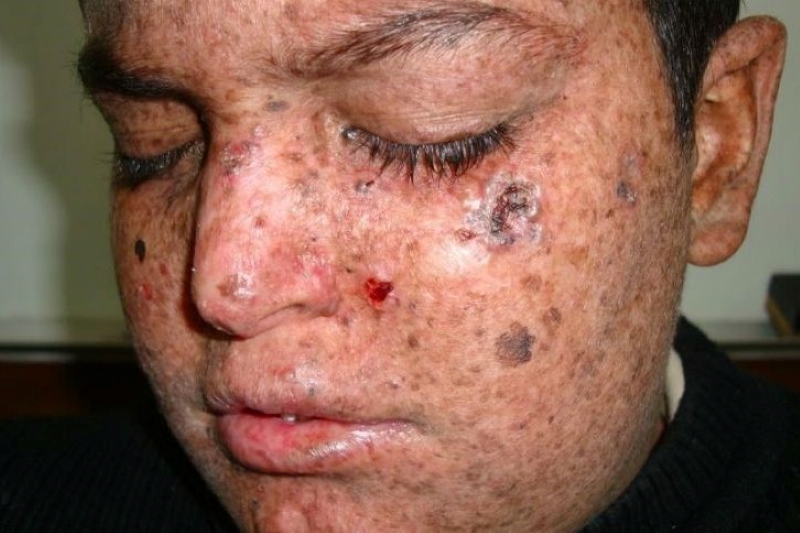
Skin diseases: xeroderma pigmentosum
Xeroderma Pigmentosum is a rare genetic disease characterized by hypersensitivity to UV radiation. It manifests with symptoms affecting the skin, eyes and nervous system. Protection from ultraviolet radiation is essential
Xeroderma Pigmentosum is a very rare skin disease, with a frequency of about one person per million in the United States and Europe
It is more common in other countries such as Japan, North Africa and Pakistan.
Xeroderma Pigmentosum manifests with abnormal sensitivity to ultraviolet radiation.
In about 60 percent of those affected, there is a risk of severe sunburn with the appearance of blisters and persistent reddening of the skin (erythema), even with minimal sun exposure.
In most children, pigmentations appear on the face similar to freckles within the first two years of life.
There is eye involvement with hypersensitivity to light, thinning (atrophy) of the skin at the level of the eyelashes, and an increased risk of skin cancers caused by sun exposure, such as basal cell or squamous cell carcinoma and melanoma.
In about 25% of those affected by this disease, neurological problems develop:
- Microcephaly;
- Sensorineural deafness;
- Psychomotor retardation.
Xeroderma Pigmentosum is a genetic condition that can be caused by alterations (mutations) in several genes
To date, there are at least 9 different genes known whose alterations can cause the disease: DDB2, ERCC1 ERCC2, ERCC3, ERCC4, ERCC5, POLH, XPA, or XPC.
Xeroderma Pigmentosum follows an autosomal recessive transmission mechanism.
Diseases with autosomal recessive transmission occur only in people who have inherited two altered (mutated) copies of a gene.
Both the copy inherited from mother and the copy inherited from father are mutated. The term “recessive” means that the alteration of only one of the two gene copies is not sufficient to cause the disease.
To cause the disease, both copies of the genes must be mutated.
Parents carry only one copy of the altered gene (the other copy is normal) so they are not sick: they are healthy carriers.
Two healthy carriers who want to have children have, with each pregnancy, a 25% chance (one in four) of having a sick child.
Fifty percent of their children will be healthy carriers (like the mother or father, without symptoms) and the remaining 25 percent will be healthy (with both copies of the gene without the mutation).
These odds are independent of the sex of the unborn child.
Xeroderma pigmentosum should be suspected in patients presenting with the symptoms listed below in the skin, eye, and nervous system
Skin:
Sensitivity to ultraviolet radiation with severe sunburn or blistering and persistent erythema, even with minimal sun exposure;
Areas of discoloration (pigmentation) on the face resembling freckles before two years of age;
Skin tumors within the first decade of life.
Eye:
Sense of discomfort caused by light (photophobia), keratitis, corneal opacity, increased pigmentation at eyelids with loss of eyelashes, thinning of eyelid skin.
Nervous system:
Progressive sensorineural deafness, microcephaly, progressive cognitive delay.
The diagnosis of Xeroderma Pigmentosum is made on the basis of the patient’s clinical features and confirmed by genetic analysis
Genetic analysis includes the molecular study of genes whose alterations, to date, we know can cause Xeroderma Pigmentosum.
The genetic study can be performed by a multigenic panel that simultaneously analyzes the genes: DDB2, ERCC1, ERCC2, ERCC3, ERCC4, ERCC5, POLH, XPA, or XPC.
There is no specific therapy available for Xeroderma Pigmentosum, and therapy is symptomatic.
Patients should avoid sun exposure, use sunscreen with maximum protection, wear clothes that protect against UV rays, protect indoor environments by applying anti-UV films to windows, and possibly changing UV-emitting bulbs with UV-free bulbs.
Intake is multidisciplinary.
It is essential to initiate a surveillance program for the occurrence of cancerous lesions that will allow early initiation of treatment.
Vitamin D deficiency is common, which is treated with supplements.
The prognosis of Xeroderma pigmentosum is variable
It is better in people who do not develop neurological symptoms and who strictly adhere to precautions to avoid exposure to ultraviolet radiation.
However, in addition to skin cancer, neurological disorders that are progressive can also reduce life expectancy.
Read Also:
Emergency Live Even More…Live: Download The New Free App Of Your Newspaper For IOS And Android
Basal Cell Carcinoma, How Can It Be Recognised?
Autoimmune Diseases: Care And Treatment Of Vitiligo
Epidermolysis Bullosa And Skin Cancers: Diagnosis And Treatment
SkinNeutrAll®: Checkmate For Skin-Damaging And Flammable Substances
Healing Wounds And Perfusion Oximeter, New Skin-Like Sensor Can Map Blood-Oxygen Levels
Psoriasis, An Ageless Skin Disease
Psoriasis: It Gets Worse In Winter, But It’s Not Just The Cold That’s To Blame
Childhood Psoriasis: What It Is, What The Symptoms Are And How To Treat It
Topical Treatments For Psoriasis: Recommended Over-The-Counter And Prescription Options
What Are The Different Types Of Psoriasis?
Phototherapy For The Treatment Of Psoriasis: What It Is And When It Is Needed
Skin Diseases: How To Treat Psoriasis?


